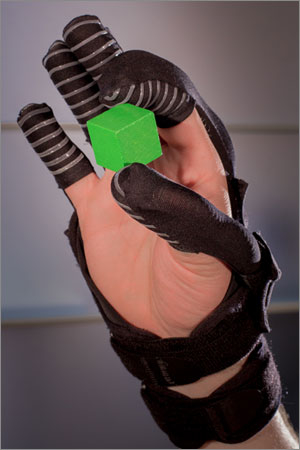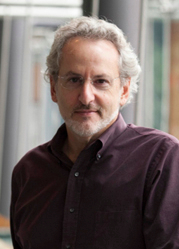Harvard Wyss Institute Develops Soft Robotic Glove For Hand-Impaired Patients

A lightweight robotic glove developed by engineers at the Wyss Institute for Biologically Inspired Engineering and Harvard John A. Paulson School of Engineering and Applied Sciences (SEAS) in Boston and Cambridge, Massachusetts is bringing the ultimate goal of providing muscle and neurologically impaired patients with the ability to independently grasp objects.
A team of engineers led by soft wearable robotics expert Conor Walsh, Ph.D., have achieved promising results in proof of concept soft robotic glove prototyping and experimental testing of a technology they believe could eventually help people who suffer from hand motor control loss to regain a measure of daily routine independence.
Patients with either partial or total loss of hand motor abilities caused by muscular dystrophy, amyotrophic lateral sclerosis (ALS), incomplete spinal cord injury, or other hand impairments experience radically diminished quality of life due to losing the ability to perform myriad normal daily living activities — tasks the able-bodied mostly take for granted like buttoning a shirt, picking up a telephone, or using cooking and eating utensils — all of which become frustrating and nearly impossible obstacles to surmount for individuals with reduced gripping strength and diminished motor control in their hands.
However, development of soft, wearable robotic systems and the Wyss Institute’s “from bench to bedside” translational approach will enable potential end users of the glove to be involved in every step of testing and development. This holistic approach ensures that technology development transcends the achievement of biomechanical functionality with the glove device and will also address social and psychological elements of robotic design that promote translation and seamless adoption by its intended end user cohort, allowing them to regain some of their daily independence through robotic glove assisted hand functions.
 Photo Caption – A soft robotic glove under development at the Wyss Institute could one day be an assistive device used to help persons suffering from muscular dystrophy, amyotrophic lateral sclerosis (ALS), incomplete spinal cord injury, or other hand impairments to grasp objects and thereby regain some daily independence and control of their environment. Image Credit: Wyss Institute at Harvard University
Photo Caption – A soft robotic glove under development at the Wyss Institute could one day be an assistive device used to help persons suffering from muscular dystrophy, amyotrophic lateral sclerosis (ALS), incomplete spinal cord injury, or other hand impairments to grasp objects and thereby regain some daily independence and control of their environment. Image Credit: Wyss Institute at Harvard University
“From the start of this project, we’ve focused on understanding the real world challenges facing these patients by visiting them in their homes to perform research,” says Dr. Walsh in a Wyss Institute release. A Wyss Institute Core Faculty member, founder of the Harvard Biodesign Lab, and Assistant Professor of Mechanical and Biomedical Engineering at SEAS, Dr. Walsh’s current research interests include new approaches to design, manufacture and control of wearable robotic devices and characterizing their performance through biomechanical and physiological studies.
The Harvard Biodesign Lab brings together researchers from the engineering, industrial design, apparel, clinical and business communities to develop new technologies and translate them to industrial partners. Dr. Walsh’s research focuses on applying disruptive technologies to development of robotic devices for augmenting and restoring human performance. A team of undergraduate students also contributed to an early glove design as part of his ES227 Medical Device Design Course.
Dr. Walsh’s long term goal is to develop fully portable wearable robots to assist both disabled and able-bodied persons and to further scientific understanding of how humans interact with such machines. With his broad range of interests in medical devices and robotics, he collaborates closely with Wyss staff in the Bioinspired Robotics and Anticipatory Medical and Cellular Devices platforms.
Another of his passionately held objectives is to educate future innovators, a goal toward which he has established the Harvard Medical Device Innovation Initiative that provides students with the opportunity to collaborate with clinicians in Boston asin well as emerging regions such as India.
 Wyss Technology Development Fellow Panagiotis Polygerinos, Ph.D., and Wyss Mechanical Engineer Kevin Galloway, Ph.D. have incorporated patient feedback at every stage of the robotic glove’s development with the objective of maximizing its translation potential.
Wyss Technology Development Fellow Panagiotis Polygerinos, Ph.D., and Wyss Mechanical Engineer Kevin Galloway, Ph.D. have incorporated patient feedback at every stage of the robotic glove’s development with the objective of maximizing its translation potential.
“Ultimately, patients have to be comfortable with wearing the glove,” Dr. Galloway observes. “In addition to glove function, we found that people cared about its appearance, which could have a big impact on whether or not the glove would be a welcome part of their daily routine.”
Dr. Walsh’s team has adapted the glove’s mechanics in order to make it more comfortable and natural-feeling to wearers. For example, over several design iterations, the actuators that power the glove’s movements were made smaller and their contours modified to distribute forces more evenly over the wearer’s fingers and thumb. The resulting soft, multisegment actuators, which are made of a composite tubular material incorporating of Kevlar fibers and silicone elastomer, support the range of motions performed by biological fingers. The glove’s portable lightweight control system supports its being worn on a waist belt or attachment to a wheelchair.
Currently, the team is working on refining their glove control strategies that will allow the system to detect and interpret the wearer’s intent. One potential solution is to leverage of surface electromyography using small electrical sensors in a cuff worn around the patient’s forearm. The electromyography sensors that can be used to directly control the glove, work by detecting residual muscle signals fired by motor neurons in response to the wearer’s attempts to perform grasping motions.
“We are continuing to test the design of the soft robotic glove on patients, in relation to making it customizable for the specific pathologies of each individual and understanding what control strategies work best but we’re already seeing a lot of exciting proofofconcept experimental results,” Dr. Walsh explains. “The current goal is to refine the overall system sufficiently so we can begin a feasibility trial with multiple patients later this year.”
 Dr. Walsh and his research and development team have been aided in their work through the key expertise of two other Wyss Core Faculty members George Whitesides, Ph.D. , who is also the Woodford L. and Ann A. Flowers University
Dr. Walsh and his research and development team have been aided in their work through the key expertise of two other Wyss Core Faculty members George Whitesides, Ph.D. , who is also the Woodford L. and Ann A. Flowers University  Professor at Harvard, and Robert Wood, Ph.D. , who is also the Charles River Professor of Engineering and Applied Sciences at SEAS.
Professor at Harvard, and Robert Wood, Ph.D. , who is also the Charles River Professor of Engineering and Applied Sciences at SEAS.
The glove’s design has been published in Robotics and Autonomous Systems journal in a Corrected Proof article entitled “Soft robotic glove for combined assistance and at-home rehabilitation” (Robotics and Autonomous Systems doi:10.1016/j.robot.2014.08.014) . The Wyss engineering team also recently presented the glove design at the International Conference on Robotics and Automation 2015 at Seattle, Washington.
The Robotics and Autonomous Systems paper, coauthored by Panagiotis Polygerinos, Zheng Wang, Kevin C. Galloway, Robert J. Wood, and Conor J. Walsh, presents a design for a portable, assistive, soft robotic glove intended to augment hand rehabilitation for individuals with functional grasp pathologies. They describe their robotic glove’s utilization of soft actuators consisting of molded elastomeric chambers with fiber reinforcements that induce specific bending, twisting and extending trajectories under fluid pressurization, and how these soft actuators are mechanically programmed to match and support the range of motion of individual fingers. The coauthors also explain how the device has demonstrated ability to generate significant force when pressurized and exhibited low impedance when un-actuated, with a control hardware system designed to include fluidic pressure sensors in line with the hydraulic actuators and a closed-loop controller to regulate pressure.
The Wyss team reports that demonstrations with the complete system have been performed to evaluate the soft robotic glove’s capability to carry out gross and precise functional grasping, concluding that compared to existing devices, their device has potential to increase user freedom and independence through its portable waist belt pack and open palm design.
This coming August, the team’s electromyography control work will be presented at the International Conference on Robotics Research 2015, which is being held in Singapore in November.
Down the road, the Wyss release notes that the team is interested in developing the glove beyond its central purpose as an assistive device to a rehabilitation tool for various hand pathologies, and also in extending the glove’s assistive functions beyond the joints in the hand towards the development of soft robotic systems that aid impaired elbow and shoulder movements as well.
 “Science benefits from an environment that allows access to valuable insights that can only be gained by working with actual potential end users of a developing technology”, observes Wyss Institute Founding Director Donald Ingber, M.D., Ph.D., who is also the Judah Folkman Professor of Vascular Biology at Harvard Medical School and Boston Children’s Hospital and Professor of Bioengineering at SEAS. “Conor and his team have made every effort to understand the real needs of hand impaired patients, and design their glove accordingly. Their success is a great demonstration of the power of the Institute’s approach to technology development.”
“Science benefits from an environment that allows access to valuable insights that can only be gained by working with actual potential end users of a developing technology”, observes Wyss Institute Founding Director Donald Ingber, M.D., Ph.D., who is also the Judah Folkman Professor of Vascular Biology at Harvard Medical School and Boston Children’s Hospital and Professor of Bioengineering at SEAS. “Conor and his team have made every effort to understand the real needs of hand impaired patients, and design their glove accordingly. Their success is a great demonstration of the power of the Institute’s approach to technology development.”
Sources:
Wyss Institute for Biologically Inspired Engineering at Harvard University
The Harvard John A. Paulson School of Engineering and Applied Sciences
Robotics and Autonomous Systems
Image Credits
Wyss Institute for Biologically Inspired Engineering at Harvard University
The Harvard John A. Paulson School of Engineering and Applied Sciences






